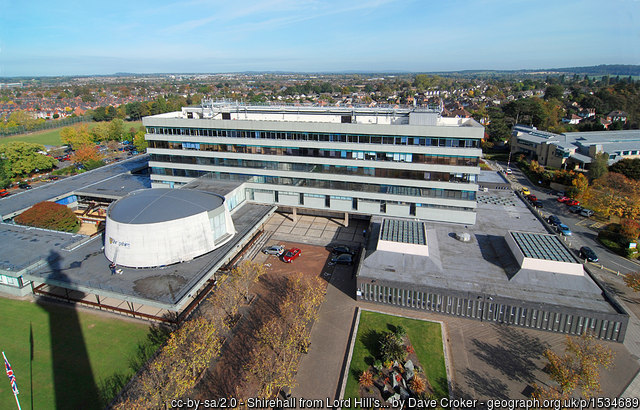Yesterday, Historic England issued a decision on the listing of Shirehall on Abbey Foregate. The secretary of state has decided not to list the 1960s civic building. He has said he is minded refusing a certificate of immunity to prevent the building being demolished but that is now a technicality unless there is a legal challenge to the refusal of listing.
The decision will clear the way for the 10-acre site to be cleared for housing and Shropshire Council can put the money towards its shopping centres which very soon will have absorbed more than £60 million of public money. That money could have provided at least 250 social homes. But the council leadership is saddled with the centres which are only worth two-thirds of the money the council paid for them three years ago and that is its priority for spending.
Update: After I published this post the Twentieth Century Society published an article supporting the listing of Shirehall.
There are those that are fond of Shirehall. Perhaps rather more people hate the huge 1960s building. Once a proud civic building towered over by Lord Hill on his pillar, it has been neglected by Shropshire Council. Council leaders have waxed and waned about what to do with it. Two years ago, plans were drawn up for an expensive refurbishment but the hatred of the building by many councillors ran deep. In July, councillors agreed to investigate options for relocating the council to a new civic centre in the town centre, with the failing Pride Hill shopping centre being a favourite location. These plans are still under wraps and we are unlikely to get more detail until the council meets again in December.
What is clear that converting Pride Hill into a leisure anchor, and cultural and civic hub will cost around £16 million. The council has £5 received million from the Local Enterprise Partnership towards this – Telford and Wrekin spent its LEP money on affordable housing – but there is still a shortfall. Council leader Peter Nutting recently told BBC Radio Shropshire that the money will come from the sale of Shirehall. He dismissed arguments in favour of refurbishing the building.
Now, the end of Shirehall is on the cards. One the same July day Shropshire councillors agreed to explore options for the town centre civic hub, council managers had applied to Historic England for a certificate of immunity (COI) from listing. This process asks the question, is this building potentially of sufficient merit to be listed? At the same time, two applications for listing the building were made.
A Save Our Shirehall group was set up. A petition reached 70 signatures, low for this internet enabled age. Twenty-four emails were received by Historic England objecting to the COI.
Historic England then assessed the building against its criteria. Its report says: “Architectural interest will be the principal determinant in assessing modern civic buildings, and because of their symbolic status, quality and finesse will be of great importance.” The report continues:
“Shrewsbury’s Shirehall dates from 1963-1966, and was designed by the County Architects’ Department under Ralph Crowe. Like their predecessors, town or county halls in the 1960s were intended to instil civic pride and to project civic identity, embodying associations of authority and reliability, with symbolic gestures alluding to power and social structure…
“In some ways the Shirehall is an archetype, though the question remains as to whether it is special, or typical, for the period. Undeniably a striking building, it is a large complex at the entrance to Abbey Foregate and the town beyond, and when viewed from the south, its composition is strong. It is carefully positioned, set back from the highway and the vertical landmark of Lord Hill’s column (listed at Grade II*). A broad concourse marks the entrance, and is flanked by humanely-scaled, single-storey blocks which wrap around the front and sides of the building. The scale increases as the building steps back…
“It is the committee suite which is most notable. Full-height glazing distinguishes this ceremonial area. The council chamber foyer is impressive for its generous scale, dual aspect, and coffered ceiling. The council chamber’s interest is gained from its drum-like form, lit from either side by great glazed openings, with its sculptural sounding board and slatted timber cladding…
“The relief mural in the main reception, referencing the nearby industrial Coalbrookdale is a highly positive attribute.”
The report compares the building to the civic buildings built in Newcastle, Plymouth and Truro during the 1950s and 1960s:
“Against these examples, the Shirehall does not compare favourably.”
Historic England concludes that the building falls just short of meeting its standard for listing post-modern buildings:
“The degree of special interest required for post-war buildings is high. The Shirehall is clearly a building of some distinction [but] on balance, the Shirehall falls just short of the standard required for civic buildings of the period, and so cannot be recommended for listing. A Certificate of Immunity from listing should therefore be granted.”
This is not quite the end of the matter. The Secret ary of State for Digital, Culture, Media and Sport has decided not to list the building. He has said he is not minded to issue a COI. There are now 28 days for comments on whether he will issue the COI. Given that listing has been refused, all the odds are that the COI will be issued in November.


